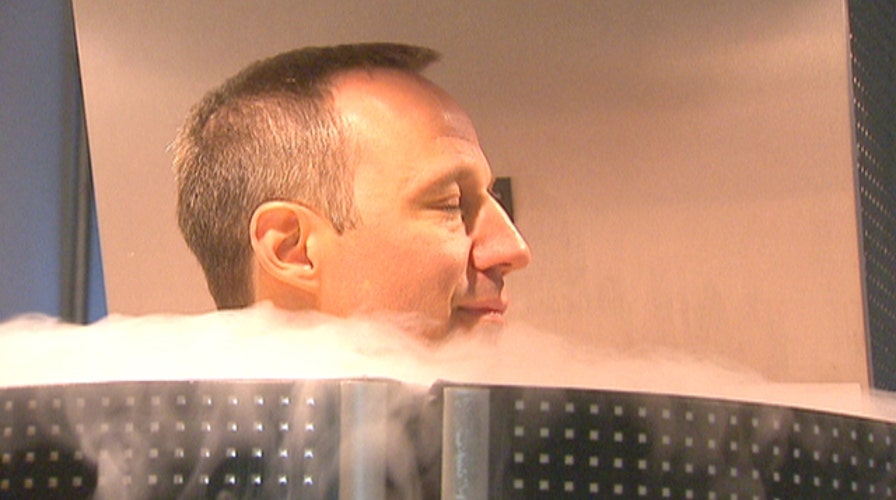Why freezing your body is the newest health trend
Chronic inflammatory pain can be difficult to treat. When cold packs and other modalities aren’t helping, could a popular European cooling treatment be the answer some patients are looking for?
Like most East Coasters, Ben Famiglietti has not enjoyed the chilly weather this winter. But that’s not stopping the 43- year-old New Yorker from trying a “cool” health trend to help treat a sports injury.
"It’s terrifically cold. It's like walking into an Arctic cloud. You go into this chamber that has no moisture and no pressure, so it's really cold,” Famiglietti told FoxNews.com.
The cooling treatment, known as cryotherapy, requires spending time in a "cryosauna" that's cooled to -264 degrees. The method is not new, but it is said to reduce inflammation, improve athletic performance and even slow signs of aging.
“We always equate cold therapy (ice) with reduction of inflammation, and cryotherapy is used every day in some form or another. ‘Cryo-’ meaning ‘cold,’ has been harnessed in liquid nitrogen and is used as routine medical and surgical techniques,” Dr. Kelly Powers, a podiatric surgeon at Stamford Hospital/NY Presbyterian, and in private practice in Greenwich, Conn., told FoxNews.com.
Freezing temperatures send the body into a "survival mode," which causes blood supply to flow to the most vital organs to relay more oxygen and nutrients. Once you leave the cold environment, the enriched and less-toxic blood is flushed back into the rest of the body.
“The whole idea of hot and cold is removing the toxins and allowing blood that doesn’t have those toxins or those inflammatory components into that area." Dr. Jennifer Solomon, a sports medicine physiatrist at Hospital for Special Surgery in New York, told FoxNews.com. “So their claim of having health benefits or skin benefits to that is the washing away of the bad [blood] and renewing it with good, vital blood.”
The cryotherapy experience
Dressed in nothing but socks, clogs and mittens, customers step into the capsule-like machine. Liquid nitrogen is used to cool down the sauna, and, after two to three minutes, skin temperature drops to 32 degrees and one can exit the polar chamber.
Once the treatment is finished, customers are advised to do a few minutes of cardiovascular exercise to warm up.
"The first thing you notice is this enormous rush of endorphins and energy afterwards, and that high lasts like five or six hours,” Famiglietti said. “You also have a little bit more mental focus, I find, and it’s like taking 16 cups of coffee with none of the side effects.”
Recovering from ankle surgery, Famiglietti does cryotherapy three times a week before his physical therapy sessions.
"It helps reduce the swelling around the joint, and that's what I’m trying to improve: range of motion and stability,” Famiglietti said.
Many doctors use ice compacts and ice machines post-op to decrease local inflammation and expedite healing. Powers has never tried whole-body cryotherapy, but she sees the potential for its use in post-surgery care and would be open to recommending it to patients.
“Not only does it stimulate and expedite the healing process, but it eliminates the discomfort that can prevent you from proper rehabilitation in tissue strengthening after muscle damage,” Powers said.
Joanna Fryben, Co-owner of KryoLife in New York said the treatment has also become popular with celebrities like Demi Moore who reportedly uses the therapy for its beauty and anti-aging benefits.
“The effects on your skin basically are immediate-- you get the healthy glow, improve circulation, and then with time, because of the boost in collagen, you see lasting effects in the smoothing of the skin tone and reducing wrinkles,” Fryben told FoxNews.com.
Although many European studies have been conducted on the effects of cryotherapy, not all doctors are convinced.
“The studies have shown that it has not been harmful in high level athletes who are healthy-- there's been no studies looking at this in an average person or anybody with any diseases or illnesses,” Solomon said. “In my opinion, if somebody has risks for heart disease or cardiac disease or a family history of stroke, I still think that this could cause a huge stress on the body, which can lead to potential dangerous issues.”
Cryotherapy is not FDA-approved, and certain medical conditions like hypertension and deep vein thrombosis can limit who should undergo the treatment. And while the company claims wearing the provided mittens and clogs can protect you from frostbite in their moisture-free sauna, risks may be involved.
“In theory, it should protect you. But I am still concerned because whenever you put your body underneath that much stress— and if you limit the blood supply to those areas— I think there is a risk for frostbite,” Solomon said.
It’s always important to talk to your doctor before trying any new treatments.
At KryoLife, a single session costs $90, and the length of time that the effects last varies.
“After the short cryotherapy stimulation, the effects last from six to eight hours, where the muscle spasticity is being reduced, when you feel endorphins release and adrenaline release. Then if you do 10-20 treatments, the effects last around two to three months," Fryben said.
For more information, visit Kryolifehealth.com.

